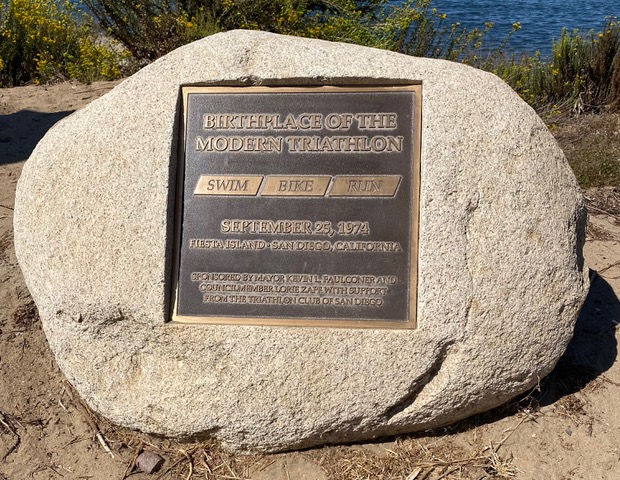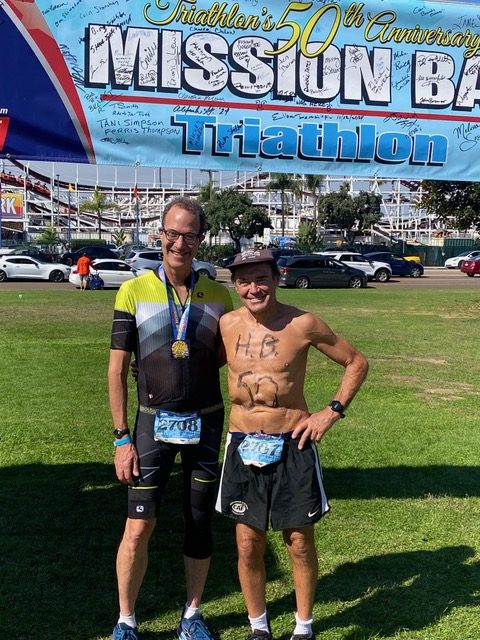As thousands of marathoners streamed through Chicago’s streets earlier this month, another endurance sport, the uber-striving triathlon, was celebrating its 50th anniversary in San Diego, routing racers in the path of its pioneers and past the sport’s Plymouth Rock.
I was among more than 1,800 competitors in the Oct. 13 Mission Bay Triathlon, relishing the contrasts with the Chicago Triathlon, which bills itself as the largest urban triathlon in the U.S.
In the San Diego race, you swim in the saltwater of Mission Bay, not the freshwater of Lake Michigan. You bike past the towering rides of SeaWorld, not the high-rises of Lake Shore Drive. And you finish, not in Grant Park, but near the historic Belmont Park wooden roller coaster, within earshot of the coaster’s rumble and the screams of riders.
Then there’s the weather — so wonderfully temperate in contrast to the late-summer heat and humidity that can assault those in the Chicago race.
But I had a special reason for taking part: My triathlon coach and former New Jersey high school cross-country teammate, Russ Jones, is a pioneer of the sport, having won the second and third triathlons held here in 1975 and 1976.
This year at Mission Bay, Jones, 69, who now lives up the freeway in San Juan Capistrano, California, evoked those pioneer days by “racing retro,” as he likes to say.
He suited up in gym shorts instead of a wetsuit. He rode a 51-year-old Raleigh 10-speed instead of an ultra-lightweight triathlon bike. It was a kick for me to mark his bare chest with “H.B. 50,” shorthand for “Happy 50th Birthday, Triathlon!”
Mounted on a rock on San Diego’s Fiesta Island, a plaque proclaims that the first modern-day triathlon happened there on Sept. 25, 1974. Forty-six adventurous athletes took part in a late-afternoon race cooked up by a swimmer, Jack Johnstone, and a runner, Don Shanahan. By combining three sports in a single race, they sought an antidote to the injury-inducing monotony of long-distance running.
The first contest, which totaled 6 miles of running, 5 miles of biking and 500 yards of swimming, was competitive, with no significant financial barriers. The entry fee: $1. Above all, it was fun.
Some participants biked on old-fashioned beach cruisers, with heavily cushioned saddles. Some took so long to finish that organizers had to turn on car lights to illuminate the course. Most went out for pizza afterward.
“There was no doubt we were on to something,” Johnstone, who died in 2016, recalled.
Indeed, they were. Four years later, two participants in that first triathlon, Judy and John Collins, inaugurated the first Ironman triathlon in Hawaii. The Ironman is a punishing 140.6-mile race that combines a 2.4-mile swim, a 112-mile bike ride and a 26.2-mile marathon.

Then, in 1982, the triathlon sport exploded into the public consciousness. With the cameras of ABC’s “Wide World of Sports” rolling, an exhausted 23-year-old Julie Moss collapsed within sight of the Ironman finish line. She crawled across it after another competitor, Kathleen McCartney, passed her to win the race — a heart-tugging display of courage known as the “Crawl of Fame.”
Since then, millions of people around the world have taken part in a triathlon. It became an Olympic sport in 2000 and is now so ubiquitous that Toyota hawks its SUVs with a “Dear Triathlon” TV ad.
The sport’s popularity “shocks me,” Shanahan, now 82, said at an Oct. 12 commemorative dinner emceed by broadcaster Bob Babbitt, a longtime triathlete who grew up in Wilmette.
To be sure, triathlon participation has dipped in recent years, in part because the sport has become expensive ($200 entry fees and $10,000 bikes are not uncommon).
But it still exerts a powerful draw, whether the race is an Ironman or a so-called sprint that typically consists of a 750-meter swim, a 20-kilometer bike ride and a 5-kilometer run. (Only in the distance-obsessed world of triathlon would such a race be deemed a sprint.) Whatever the length, competitors have a chance to push their physical and mental limits.
“When it gets really ugly ,and you have to go really deep, you discover something in yourself,” Moss, now in her 60s, told the dinner crowd as she stood on stage next to her old rival McCartney.
In rare cases, however, extreme exertion can turn fatal — a risk tragically demonstrated at last Thursday’s World Triathlon Championship in Spain.
Two participants died during the sprint event — one during the swim, the other during the run. In the wake of those deaths, organizers of the Ironman men’s world championship, happening Saturday in Kailua-Kona, Hawaii, will no doubt be extra vigilant about safety.
I didn’t push my limits at Mission Bay because a knee injury forced me to walk and jog during the run portion of the sprint race. So I smiled and took it all in — the friends and families of competitors gathered on Ventura Cove Beach at the start; the starkly beautiful, windswept landscape of Fiesta Island; and the bikini-clad beach volleyball players in Mission Bay Park.
I ended up a spot behind Jones: 13th of 30 in our 65-69 age group — my worst finish of the year.
But it was the most fun I had in any race.
As a wise friend once told me, there are races where you go all out to make the podium, and there are races that you do just for the experience. This was one of those experience races. It’s one I’ll never forget.
Blair Kamin is a former Tribune architecture critic.
Submit a letter, of no more than 400 words, to the editor here or email letters@chicagotribune.com.



